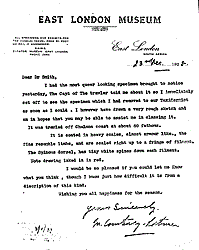|
The taxi driver must have wondered whose judgement was worse his or his passenger's. Why would anyone want to take a dead fish more than a metre long across town during the heat of the 1938 South African summer? And why did he agree to drive them?
Although the fish was unknown to her, Marjorie Courtney-Latimer knew it was special the instant she saw it on South Africa's East London docks, where it had been left for her by a trawler captain who saved unusual specimens for her small local museum. Unable to identify it, she drew a sketch to accompany a letter sent to Grahamstown, South Africa asking colleague Dr. J.L.B. Smith for help. This letter astonished him, for he was certain the fish she described was a coelacanth -- a family of fishes well known from the fossil record, but presumed extinct for 75 million years. When he was finally able to examine the fish a few months later he confirmed his suspicions: it was a coelacanth -- as amazing and improbable as a Stegosaurus at the breakfast table. |

 The fateful letter from Marjorie Courtney-Latimer (who later earned her Ph.D. and was knighted) to Dr. J.L.B. Smith. The fateful letter from Marjorie Courtney-Latimer (who later earned her Ph.D. and was knighted) to Dr. J.L.B. Smith.
|

 Marjorie Courtney-Latimer's quick sketch of the mystery fish was instantly recognizable as a coelacanth to the incredulous, and thrilled, J.L.B. Smith. Marjorie Courtney-Latimer's quick sketch of the mystery fish was instantly recognizable as a coelacanth to the incredulous, and thrilled, J.L.B. Smith.
|
Dr. Smith named the new species Latimeria chalumnae, and focused his field work to find more specimens further north in the Indian Ocean around Madagascar, where he thought the coelacanth originated. Because the taxidermist could not preserve the soft body parts of the specimen, Smith was determined that another specimen must be found to allow the creature to be properly documented for science. He and his wife spread the word of their search on their scientific travels, and, incredibly, it paid off. In late 1952, a coelacanth was caught off the coast of the Comoro Archipelago. Desperate to recover the specimen intact, Smith convinced South African Prime Minister Malan to provide him with a military plane and crew to retrieve it. Smith wrote that when he saw the second coelacanth, he wept. |
On July 30 1998, an entire population of coelacanths was discovered thanks to a fishing crew setting gill-nets near Indonesia, almost 10 000 km from the Comoran population. In 1999 the animals in this population were identified as a different species, which was named Latimeria menadoensis, and is commonly known as menado coelacanth.
Since 1952 many scientific disciplines have extensively studied the coelacanth. Evolutionary biologists have long thought the species a close relative of the ancestor of all tetrapods (four-legged creatures), Homo sapiens included. The debate over the coelacanth's place in evolution is ongoing, but detailed anatomical study has left no doubt that this animal has a number of unique characteristics, including a joint in its braincase that divides it front and back, and an organ in its snout thought to be electro-receptive. Live observation from a submersible in 1987 by a team of scientists led by Dr. Hans Fricke witnessed acrobatic behaviours otherwise unknown in the fish world.
The living coelacanth is truly a wonder of nature. Only a few dozen specimens are in museum collections worldwide. The Canadian Museum of Nature is proud to possess one in its collection. |

 The poster that accomplished the unlikely. Printed in the colonial languages of the region, this poster was distributed through a network of friends and strangers. The poster that accomplished the unlikely. Printed in the colonial languages of the region, this poster was distributed through a network of friends and strangers.
|
|


